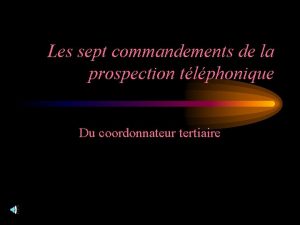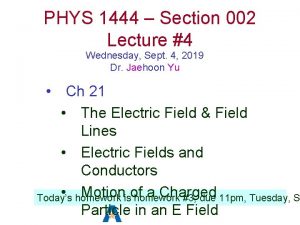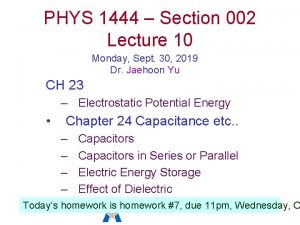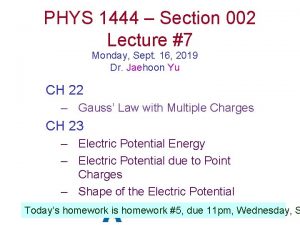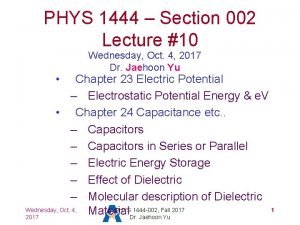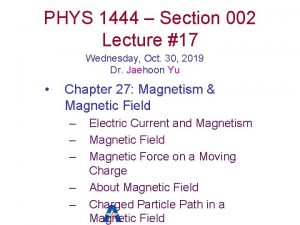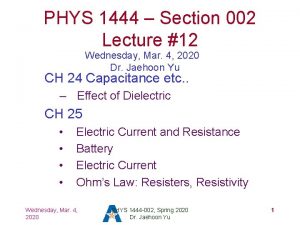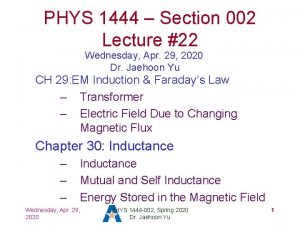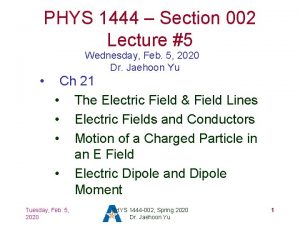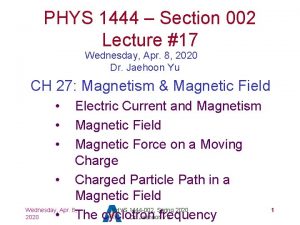PHYS 1444 Section 002 Lecture 8 Wednesday Sept












- Slides: 12

PHYS 1444 – Section 002 Lecture #8 • Wednesday, Sept. 27, 2017 Dr. Jaehoon Yu Chapter 23 Electric Potential – Electric Potential due to Point Charges – Shape of the Electric Potential – V due to Charge Distributions Equi-potential Lines and Surfaces – Electric Potential Due to Electric Dipole Electrostatic Potential Energy Wednesday, Sept. – PHYS 1444 -002, Fall 2017 27, 2017 Dr. Jaehoon Yu 1

• Quiz #2 Announcements – Coming Monday, Oct. 2, at the beginning of the class (CH 23. 8? ) – Covers CH 22. 1 through what we cover in class today – Bring your calculator but DO NOT input formula into it! • Cell phones or any types of computers cannot replace a calculator! – BYOF: You may bring a one 8. 5 x 11. 5 sheet (front and back) of handwritten formulae and values of constants for the quiz – No derivations, word definitions or solutions of any problems! – No additional formulae or values of constants will be provided! • Mid-term results – Class average: 48. 1/95 Wednesday, Sept. PHYS 1444 -002, Fall 2017 • Equivalent to 50. 6/`00 27, 2017 Dr. Jaehoon Yu 2


Reminder: Special Project #3 • Particle Accelerator. A charged particle of mass M with charge -Q is accelerated in the uniform field E between two parallel charged plates whose separation is D as shown in the figure on the right. The charged particle is accelerated from an initial speed v 0 near the negative plate and passes through a tiny hole in the positive plate. – Derive the formula for the electric field E to accelerate the charged particle to a fraction f of the speed of light c. Express E in terms of M, Q, D, f, c and v 0. – (a) Using the Coulomb force and kinematic equations. (8 points) – (b) Using the work-kinetic energy theorem. ( 8 points) – (c) Using the formula above, evaluate the strength of the electric field E to accelerate an electron from 0. 1% of the speed of light to 90% of the speed of light. You need to look up the relevant constants, such as mass of the electron, charge of the electron and the speed of light. (5 points) • Due beginning of the class Monday, Oct. 2 Wednesday, Sept. 27, 2017 PHYS 1444 -002, Fall 2017 Dr. Jaehoon Yu 4

Electric Potential and Electric Field • The effect of a charge distribution can be described in terms of electric field or electric potential. – What kind of quantities are the electric field and the electric potential? • Electric Field: Vector Scalar • Electric Potential: – Since electric potential is a scalar quantity, it is often easier to handle. • Well other than the above, how are these two quantities related? Wednesday, Sept. 27, 2017 PHYS 1444 -002, Fall 2017 Dr. Jaehoon Yu 5

• Electric Potential and Electric Field Potential energy change is expressed in terms of a conservative force (point a at a higher potential) • For the electrical case, we are more interested in the potential difference: – This formula can be used to determine Vba when the electric field is given. • When the field is uniform so What does “-”sign mean? The direction of E is along that of decreasing potential Wednesday, Sept. PHYS 1444 -002, Fall 2017 6 V/m Can you derive this from N/C? Unit of the electric field in terms of potential? 27, 2017 Dr. Jaehoon Yu

Example Uniform electric field obtained from voltage: Two parallel plates are charged to a voltage of 50 V. If the separation between the plates is 5 cm 5. 0 cm, calculate the magnitude of the 50 V electric field between them, ignoring What is the relationship between electric field any fringe effect. the potential for a uniform field? Solving for E Which direction is the Direction of decreasing field? potential! Wednesday, Sept. PHYS 1444 -002, Fall 2017 27, 2017 Dr. Jaehoon Yu 7

• Electric Potential due to Point Charges What is the electric field by a single point charge Q at a distance r? • Electric potential due to the field E for moving from point ra to rb in radial direction away from the charge Q is Wednesday, Sept. 27, 2017 PHYS 1444 -002, Fall 2017 Dr. Jaehoon Yu 8

• Electric Potential due to Point Charges Since only the differences in potential have physical meaning, we can choose at. • The electrical potential V at a distance r from a single point charge Q is • So the absolute potential by a single point charge can be thought of the potential Wednesday, Sept. PHYS 1444 -002, Fall 2017 9 difference by a single point charge 27, 2017 Dr. Jaehoon Yu

• Properties of the Electric Potential What are the differences between the electric potential and the electric field? – Electric potential • Electric potential energy per unit charge • Inversely proportional to the distance • Simply add the potential by each of the source charges to obtain the total potential from multiple charges, since potential is a scalar quantity – Electric field • Electric force per unit charge • Inversely proportional to the square of the distance • Need vector sums to obtain the total field from multiple source charges • Potential due to a positive charge is a large positive near the PHYS charge and decreases towards 0 Wednesday, Sept. 1444 -002, Fall 2017 10 27, 2017 at the large distance. Dr. Jaehoon Yu

Shape of the Electric Potential • So, how does the electric potential look like as a function of distance? – What is the formula for the potential by a single charge? Positive Charge Negative Charge Uniformly charged sphere would have the potential the same as a single poin Wednesday, Sept. PHYS 1444 -002, Fall 2017 11 Uniformly charged sphere behaves like all the charge is on the single poin What does this mean? 27, 2017 Dr. Jaehoon Yu

Example 23 – 6 Work to bring two positive charges close together: What is minimum work required by an external force to bring the charge q=3. 00μC from a great distance away (r=∞) to a point 0. 500 m from a charge μC? What is. Q=20. 0 the work done by the electric field in terms of potential energy and potential? Since obtain we Electric force does negative work. In other words, the external force must work +1. 08 J to bring the charge 3. 00μC from infinity to Wednesday, Sept. PHYS 1444 -002, Fall 2017 12 0. 500 m to the charge 20. 0μC. 27, 2017 Dr. Jaehoon Yu
 First world country
First world country Physics 241
Physics 241 01:640:244 lecture notes - lecture 15: plat, idah, farad
01:640:244 lecture notes - lecture 15: plat, idah, farad Un deux trois quatre cinq six sept
Un deux trois quatre cinq six sept La guerre de sept ans
La guerre de sept ans Candide ou l optimisme
Candide ou l optimisme Cities on hills
Cities on hills Dessin poésie le blaireau sans gêne
Dessin poésie le blaireau sans gêne Ecrivez les sept jours de la semaine
Ecrivez les sept jours de la semaine Sept commandements
Sept commandements Cnn 10 august 31
Cnn 10 august 31 Sept heure moins le quart
Sept heure moins le quart Accu poole sept
Accu poole sept









